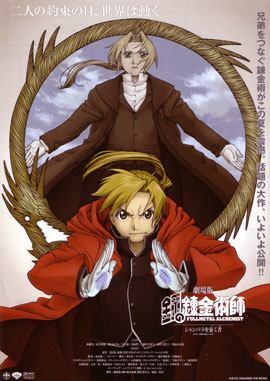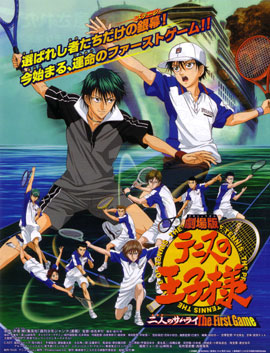Shochiku Adds Animation
The Film Series > Shochiku Animation > Film Funding > Toei Animation > Film Commission > Tokyo Fest 2006
For a change of pace, let's take
a peek inside the Captain's mailbag. About the recent Bobby
Fischer piece, one reader writes:
 I
just read the Captain's
last article, and it almost sounded like real news! I
was waiting for it to take that turn down the unmarked road
into Japanesey territory. I was imaging something about, say,
an underground sub-culture of exclusive clubs catering to
rich
industrialists playing chess with a human chessboard where
the pieces are kogal
hostesses in animation
character costumes. Actually, if that doesn't already exist
it sounds like a pretty good profit venture.
I
just read the Captain's
last article, and it almost sounded like real news! I
was waiting for it to take that turn down the unmarked road
into Japanesey territory. I was imaging something about, say,
an underground sub-culture of exclusive clubs catering to
rich
industrialists playing chess with a human chessboard where
the pieces are kogal
hostesses in animation
character costumes. Actually, if that doesn't already exist
it sounds like a pretty good profit venture.
Ron
Irvine, CA
The Captain responds: Thanks for writing. Certainly all stories are, as you say, "real news," but a concession could be made in that some are a tad more colorful than others. And, perhaps sadly, this week
is a plunge back to the monochrome wire-service world with a profile of film giant Shochiku's
new animation division.
Readying more robots
for battle.
Japanese film giants Toei and Toho probably
cast nervous looks over their backs in September, when film-distribution
and kabuki-theater conglomerate
Shochiku established an animation division to increase
its share of Japan's $18 billion annual animation
market.
"We now have the ability to expand our
animation business," says division general manager Ichiro
Seki.
Shochiku, which has animation experience with
the “Gundam” robots and “Ultraman,”
will now have the increased flexibility needed to commission
a larger selection of features and provide unique marketing
options.
Seki believes that his company's strong relationship
with some of Japan's top animation studios will be important.
Features to be distributed this year include
Sunrise Animation's “Mobile Suit Z Gundam,” a
film sequel to the popular TV series, and Gonzo's “Fullmetal
Alchemist,” a post-WWI adventure story set in Germany.
“The Glass Mask,” based on Suzue
Miuchi’s two-decade long coming-of-age manga
series popular among young women, became the division's first
weekly terrestrial TV series when it began last month on TV
Tokyo.
Over the next three years Shochiku expects
to release 10 weekly TV series and 13 feature-length films.
Such an unprecedented plan, Seki says, is made
possible due to a new ability to give priority to particular
projects and financial freedom.
 "Prior
to the division's formation, animation films had equal priority
with live-action films when it came to financing, but now
the Animation Division has its own budget," says Seki.
"Prior
to the division's formation, animation films had equal priority
with live-action films when it came to financing, but now
the Animation Division has its own budget," says Seki.
While skeptics may scratch their heads at Shochiku’s
old-fashioned kabuki pedigree, the 115-year old company, known
in recent years primarily for distributing live-action films
(“The Twilight Samurai,” for example), sees its
diversity as an advantage.
In addition to merchandising and distribution
of animation oeuvres, it plans to host special promotional
events and stage plays based on some of its new features.
“The Prince of Tennis,” a teenage tennis movie
nearing the end of its theater run in Japan, is scheduled
to become a theater musical.
The 14-employee division will also be expanding
into developing characters, a niche that the company thinks
will make it more competitive.
"Our goal is to create a trading company
in character goods," Seki says, adding that this is a
contrast to Toho, which focuses primarily on distributing
feature films.
This will involve acquiring character licenses
and merchandising rights, in some cases for characters not
specifically related to animation.
Sanrio's Hello Kitty would be a model for the latter.
To tap the booming international animation
market, “Grenadier,” the adventures of a sexy
buxom blonde, will be released in a series of DVDs in
the U.S. “Karas,” the story of an armored ninja,
and “Spirit,” a futuristic adventure amid world
environmental decline, are both currently in negotiations
for overseas distribution.
Peter Brinham, a Tokyo-based media finance
specialist, says that Shochiku was late to cash in on the
surprise groundswell in animation’s global popularity.
The challenge for the company, Brinham adds,
will be in making smart hiring choices. "Since the Japanese
animation business is very fragmented," he says, "personal
relationships and individual know-how remain at a premium."
Seki remains confident. Though he doesn't expect
the division to have an immediate impact on the company’s
pursuit of top distributor Toho, he foresees a noticeable
improvement in perhaps five years.
Establishing an in-house animation
studio similar to that of its rival Toei is not in Shochiku's
immediate plans. Instead, the creative focus of the division
will be in teaming up with the next Hayao Miyazaki (director
of “Spirited Away”) or Katsuhiro Otomo (“Akira”)
from outside Shochiku.
"While fostering and working with new-comers,"
Seki says, "we would like the Shochiku Animation Division
to grow up along with them."
Note: This story was originally featured
in Variety as a part
of a package commemorating Shochiku's 110th anniversary. Both
images are courtesy of Shochiku.
The Film Series > Shochiku Animation > Film Funding > Toei Animation > Film Commission > Tokyo Fest 2006

